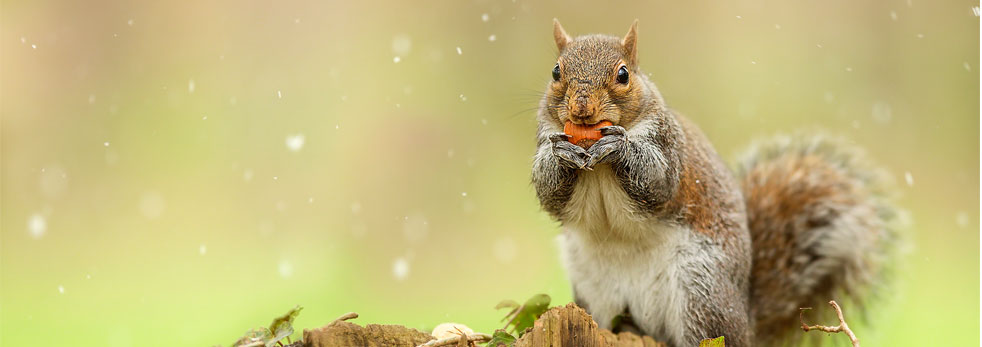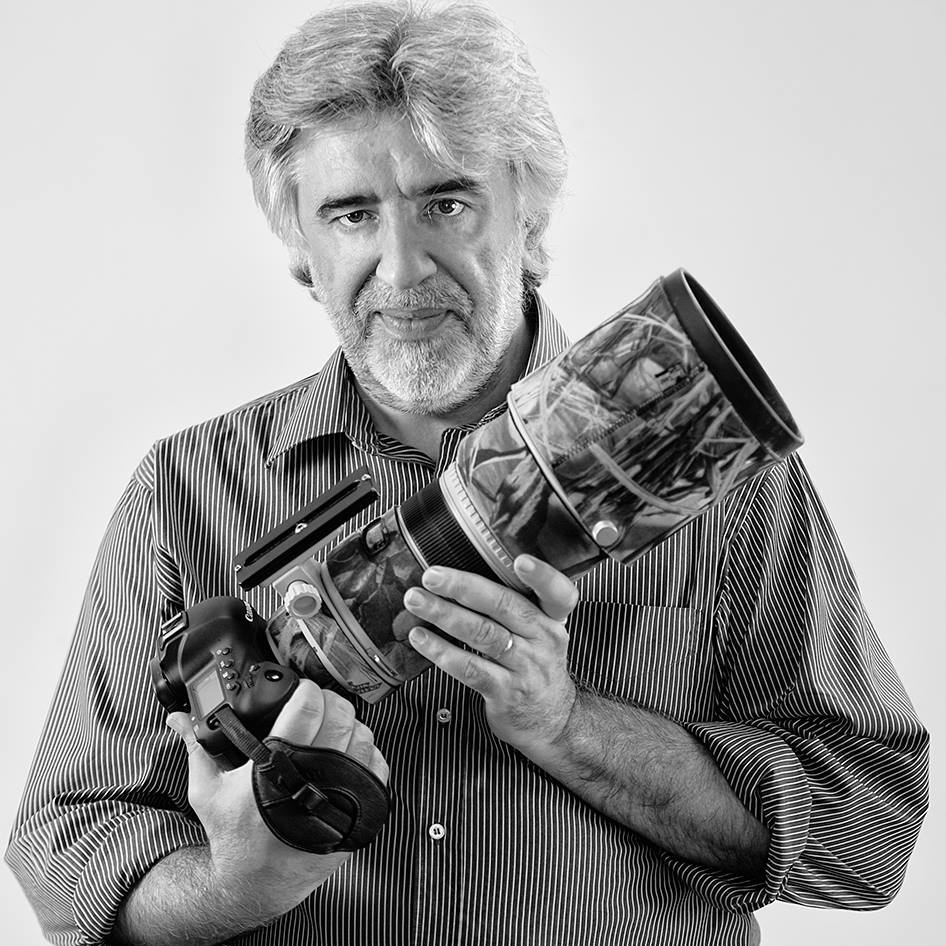
By Stefano Ronchi
Stefano started his photographic journey with an Olympus OM10, which he still owns. The advent of digital technology and the purchase of an SLR camera increased his interest and passion for photography.
He always emphasizes the dignity of the animal itself, above all in his photography, giving a representation, which is the most truthful and suggestive possible. He devotes most of his time photographing the animal world in all its forms and he loves to be with nature.
Stefano lives in Caravaggio (Bg), Italy.

Website: www.stefanoronchi.com
Facebook: www.facebook.com/Ronchifoto/
Instagram: www.instagram.com/ stefanoronchi/
Most people might find it strange, but a squirrel has always been for me the most fascinating animal to spend time with and photograph. How can you not fall in love with its cute snout, with the light, elegant and still brave way it takes flight from one branch to another, with its way of running on arduous fences to get to food, with its frenetic antics in order to reach for a desired walnut and digging the ground to hide it. All this made the squirrel the most enjoyable and intriguing animal to me. A squirrel is an expert jumper and its favorite places are woodlands. It feeds mainly on nuts, acorns, mushrooms and fruits, which it stores in well-hidden places (which are sometimes forgotten and thus contributing in spreading plant species). Its natural predators are Martes (Martes martes), Wild cats (Felix silvestris) and several species of birds of prey.
The best-known gene of squirrel is Scirus, which include the Eastern Gray Squirrel of North America, the Red Squirrel of Eurasia and the Fox Squirrel of North America. Squirrels have extraordinary ability to adapt that gives them the exibility to live in close contact to human beings. Being rodents and daytime animals, it is not hard to find them in city parks. They are so used to human presence and dare get close enough to feed of a person’s hands. I can still recall when I first saw Gray Squirrels in a park with their funny way to take cover behind trees, hiding their body leaving only their little snout visible, at one time peeking from the left and the other time from the right of the tree, appearing like children playing hide-and-seek. Suddenly, you could see them chasing each other to steal nuts. A breathless run in fields and then on trees, climbing quickly, and after that a jump from a branch to another, mostly in unstable balance, but always affixed, never falling down. Then, abruptly, they reach you, looking as if they fear coming close but at the same time knowing they will be rewarded for such bravery. A fraction of a second later they take a nut from you; they curl up and protect it in their front paws; their small teeth start their feverish job and quickly the lavish meal is gone. They are ready again to face their fears and run after another nut.
Then autumn comes and in the month of November you can see squirrels preparing their pallet high on the trees. They collect leaves from the ground, fill them in their mouth helped by paws and carry them up to their nest in order to be used as sleeping material.
This way they prepare for the reproductive period, which comes twice a year between December and February and then between May and July (there can be variations in timing according to latitude). It is a peculiar moment that I always want to capture through my camera. It has been a five years long await, an effort well rewarded. I was lucky to see a squirrel collecting leaves and climb on to a branch; me getting closer made it suspicious and it decided to jump on to a close by tree. The speed of that movement and the wonder still sparkle in my eyes; the rapidity in the focus of the camera and the lens contributed to make that picture one of those I am most attached to.
I have always thought that photography should not be educational, but that it should make the observer be astonished by the magnificence of the animal world. I believe that the important thing is to give dignity to the animal you are portraying; you should try to catch the essence of its true self and to transmit all this in a picture. The Treaty of Lisbon affirmed that animals are sensible beings, meaning they have the ability to feel emotions and transmit them. Therefore the duty of a natural photographer is to educate the user of the image so that he can pick the dignity in the animal itself. If this contributes to save the life of even only one animal, the goal of the photographer will be fully attained. To this end I tried to figure out in my mind which one could be the picture best representative of a squirrel. Paying attention to them I noticed that their most peculiar characteristic are the speed of movement and the ability to jump. Particularly watching how, while running, they manage to hang midair for several milliseconds, fascinated me. There are moments when their paws do not touch the ground, the squirrel appears floating in the air as if it is fighting and winning against gravity. Therefore I looked for the right place, I drew the attention of the squirrel through the persuasion of food and I managed to fix that precise moment. Knowing I could pass that moment on to whoever viewing the picture is great by itself.
I have the possibility to make the beauty of the Gray Squirrel (Sciurus carolinensis) known, as it is recently a less loved genre. This happened because it was named in the list of the one hundred most dangerous invasive species in the world, compiled by the International Union for Conservation of Nature. Although the origin of this squirrel is in North America, it was introduced into some European countries such as Italy, Great Britain and Ireland. Its strength and its ability to adapt made the American Gray Squirrel predominate the European Red Squirrel (Sciurus vulgaris), making the indigenous squirrel extinct in certain areas. It was then decided to set plans in order to capture and eliminate the American squirrel and at the same time stop the eradication of the indigenous one. In Italy, the position of the most important association is not unambiguous. The LAV (Association Against Vivisection) considers the threat of grey squirrel with no foundation and tries to stop the EC_SQUARE project for their eradication.
On the other side, Legambiente (Association for Environment) sustains this campaign and supports legislative initiatives to forbid the selling of this species. This position is similar to the one of WWF Italy, which support the campaign and since 90s asks for a resolution to stop the selling of non-local species in order to avoid extreme measures. Also Unione Zoologica Italiana (Italian Zoological Union) is also working towards limiting the spreading of the Gray Squirrel.
In winter I love travelling to Switzerland, especially to Pontresina, a location near St. Moritz. I like to venture into Val Roseg, walk down a snow covered path, with trees showing me the way, enjoying the blowing wind and the tweeting of birds as soundtrack. A river crosses it and along the river, trees, bridges, silence follows one another, a small heaven where you can experience incredible wilderness and find your own balance in this place which is, not just by chance, called “enchanted wood.” Here a perfect unity between man and nature seems to take place, animals do not fear man and man live respecting animals. If you hold some seeds in your hand, in short time you will see birds come down looking for food, ignoring any danger. In the coldest seasons, when snow covers all the landscape, when every noise is muffled and softened, when there is lack of food and it becomes a struggle to survive, it is beautiful to walk across, holding walnuts and nuts in your hand. The empty sound of the nuts tapping, calls for the red squirrel, which at first are fearful but then come out following the bravest among them. They often fight their diffdence and come closer, at a distance of one or two metres at most. The sight of the food down on the snow and they get even closer with light and quick steps. The dark brown or bright red color of their fur contrasts the whiteness of the snow, creating an incredible effect. At that moment, you cannot help but lie completely down in the snow, almost becoming part of the habitat they live in. You take your camera, set the lens in line with their eyes and let your mind find the right inspiration to make the feeling you are experiencing becoming real. As Hanry Cartier-Bresson said, thinking that pictures are taken by camera is an illusion... they are taken by the eyes, the heart and the mind. You start clicking the picture and immediately look at the screen to understand if that moment you remember is impressed in the memory card. You lower your eyes and they find the footprints of a little friend who found its courage by itself to make that moment magical. In this way, photography becomes the way to freeze the moment and make it immortal.
Capturing those snouts, the tail they sometimes keep above their head to warm and cover themselves, is a pure emotion, the same emotion I hope I pass down through my pictures.
Image Gallery
Copyright © 2026. All rights reserved. PAWS TRAILS EXPLORERS